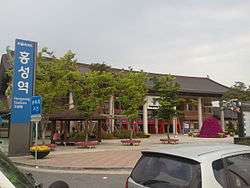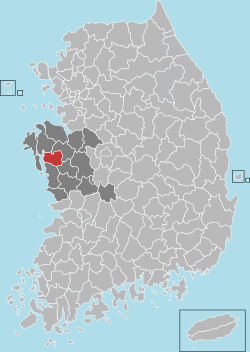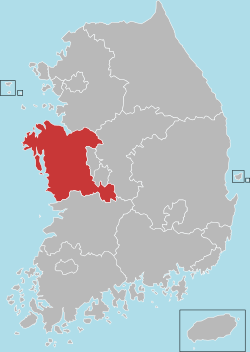Hongseong County
Hongseong (Hongseong-gun) is a county in South Korea, and the capital of South Chungcheong Province. The current governor is Kim Seok-hwan. The original name of the city is Hongju.[1]
Hongseong 홍성군 | |
|---|---|
County | |
| Korean transcription(s) | |
| • Hangul | 홍성군 |
| • Hanja | 洪城郡 |
| • Revised Romanization | Hongseong-gun |
| • McCune-Reischauer | Hongsŏng-gun |
 Hongseong Station | |
 Emblem of Hongseong | |
 Location in South Korea | |
| Coordinates: 36°35′58″N 126°39′46″E | |
| Country | |
| Region | Hoseo |
| Administrative divisions | 2 eup, 9 myeon |
| Area | |
| • Total | 443.5 km2 (171.2 sq mi) |
| Population (2013) | |
| • Total | 89,174 |
| • Density | 201.1/km2 (521/sq mi) |
| • Dialect | Chungcheong |
Symbols
- The flag represents the Joyang Gate along with the west coastal line.
- The region's flower is the forsythia, which symbolizes the warmth and kindness in the hearts of the people of Hongseong.
- The region's tree is the zelkova, which is known for providing a lot of shade. This symbolizes the loyalty and patriotism of the people of Hongseong.
- The region's bird is the magpie, which is also the national bird of Korea. It symbolizes good luck, good news and hope.[2]
Population
| Administrative District | Male | Female | Total | Percent |
|---|---|---|---|---|
| Hongseongeup | 21,370 | 21,799 | 43,169 | 49.09% |
| Gwangcheoneup | 5,547 | 5,477 | 11,024 | 12.53% |
| Hongbukmyeon | 2,312 | 2,280 | 4,592 | 5.22% |
| Gummamyeo | 1,949 | 1,934 | 3,883 | 4.42% |
| Hongdongmyeo | 1,968 | 1,873 | 3,841 | 4.37% |
| Janggokmyeon | 1,723 | 1,790 | 3,513 | 3.99% |
| Eunhamyeo | 1,438 | 1,430 | 2,868 | 3.26% |
| Gyeolseongmyeon | 1,268 | 1,282 | 2,550 | 2.90% |
| Seobumyeon | 1,824 | 2,027 | 3,851 | 4.38% |
| Galsanmyeon | 2,105 | 2,102 | 4,207 | 4.78% |
| Guhangmyeon | 2,279 | 2,170 | 4,449 | 5.06% |
| Total | 43,783 | 44,164 | 87,947 | 100% |
Historical figures
Historical figures born in Hongseong:
- Choe Yeong (1316): General during the Goryeo Dynasty[4]
- Seong Sammun (1418): Notable scholar during the Joseon Dynasty[5]
- Han Seong-jun (1875): Master of Korean dance during the Japanese Colonial Era[6]
- Han Yong-un (1879): Buddhist reformer[7]
- Kim Jwa-jin (1889): anarcho-communist activist[8]
Cultural assets
In Hongseong, a large statue of Buddha is engraved on a protruding rock carved into the shape of a shrine. Overall, the headpiece is solid and integrity is shown on the face, but the statue is unbalanced from its loss of volume towards the bottom.[9]
Site attributed to Choe Yeong:[4]
- Gibongsa: in Noeunli, shrine that was reconstructed in 1995; site of a memorial service every fall to comfort General Yeong's soul
Sites attributed to Seong Sammun:[5]
- Teacher Seong Sammum’s Tomb: in Noeunli, where his mother's family lived and where he was born; previously a lecture hall closed in 1676
- Teacher Seong Sammum Memorial Stone: in Noeunli, preservation house for engraved Yuheobi memorial stone
- Noeundan: in Noeunri, site of memorial service performed every October 10; holds Seong Sammun's ancestral tablets
Sites attributed to Han Yong-un:[7]
- Birthplace of Manhae, Han Yongwun: a memorial in Gyeolseongmyeon
- Manhaesa Shrine: in Hongbukmyeon, built to hold his portrait
- Statue of Manhae, Han Yongwun: in Namjangli, built to set his work as an indication of national spirit
- Manhae, Han Yongwun Culture Experience Hall: in Gyeolseongmyeon, built in 2007 in front of his birthplace to commemorate his spirit and philosophy
Sites attributed to Kim Jwajin:[8]
- Birthplace of General Kim Jwajin: in Paekya Park in Galsanmyeon, where he was born and raised; restoration started in 1991
- Memorial stone to pay a tribute to the memory of General Kim Jwajin: in Galsanmyeon, describes his achievements; constructed in 1949
- Statue of General Kim Jwajin: in Goamli, articulates his achievement when he wiped out a Japanese army at 31 years of age
- Baekyasa: in Galsanmyeon, shrine where service is held during the Baekya festival every October 25
Festivals
- Namdangli Cockle Festival: The coastal topographical features of the Hongseong area, particularly the Cheonsu Bay area, provide abundant egg cockles. Egg cockles taste unique and not easy to eat in city areas. Because of these reasons, the festival gradually became successful. However, an oil spill around Taean made it difficult to host this festival recently. Hongseong did not suffer direct damage from the oil spill. The county took place as the host on Jan 16 of 2008.[10][11]
- Naepo Festival: First begun in 2004, this festival honors the Naepo culture throughout Hongseong in the month of October. It represents the loyalty of the culture of Hongseong people. It includes many competitions and performances while commemorating General Choe Yeong and those who sacrificed their lives in the battle at Hongju Castle.[12]
- Festival of General Kim’s victory: This festival is held every October at General Kim Jwa-jin's birthplace and shrine to commemorate his victory in Cheongsanli. The spectacles include Bongsan Mask dancing, pungmul performance, military school events, makgeolli tasting, and more.[13]
gollark: The Chinese man is omniscient.
gollark: What do you do in this ssituation?
gollark: Phase π/4 is very similar across applicants.
gollark: Consider the generalized trolley problem.
gollark: Here is your next ethical question. What do you do, as an ethics person who is ethical?
See also
References
- "Greetings". Hong Seong official site. Retrieved 26 December 2013.
- "Flag/Flower/Tree/Bird representing the region". Hong Seong official site. Retrieved 26 December 2013.
- "Population". Hong Seong official site. Retrieved 26 December 2013.
- "Choi Young". Hong Seong official site. Retrieved 26 December 2013.
- "Seong Sammun". Hong Seong official site. Retrieved 26 December 2013.
- "Han Seongjun". Hong Seong official site. Retrieved 26 December 2013.
- "Han Yongwun". Hong Seong official site. Retrieved 26 December 2013.
- "Kim Jwajin". Hong Seong official site. Retrieved 26 December 2013.
- "Nationally Designated Cultural Property". Hong Seong official site. Retrieved 26 December 2013.
- 홍성 새조개축제 18일 개막 Yeonhap News 2008.01.16 http://news.naver.com/main/read.nhn?mode=LSD&mid=sec&sid1=101&oid=001&aid=0001895266
- "Namdangli Cockle Festival". Hong Seong official site. Retrieved 26 December 2013.
- "Naepo Festival". Hong Seong official site. Retrieved 26 December 2013.
- "Festival of General Kim's victory". Hong Seong official site. Retrieved 26 December 2013.
External links
This article is issued from Wikipedia. The text is licensed under Creative Commons - Attribution - Sharealike. Additional terms may apply for the media files.
